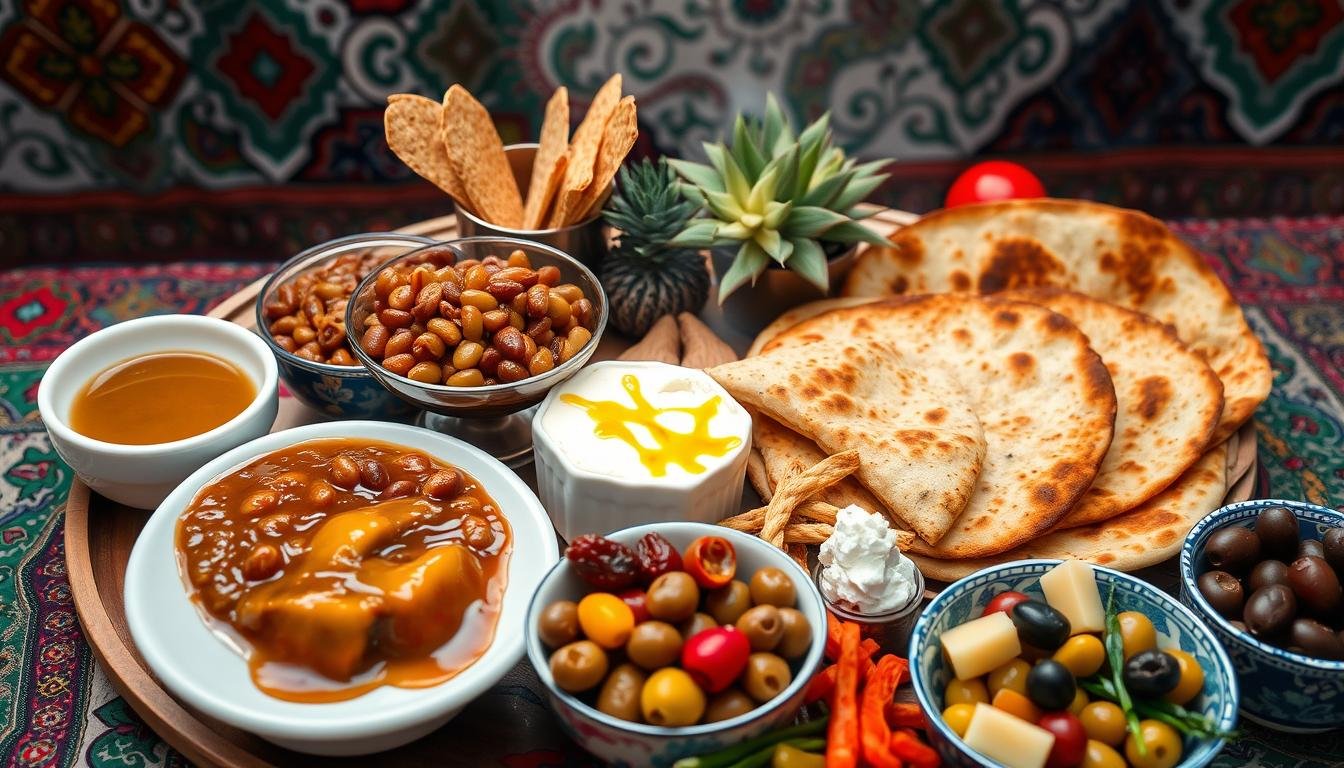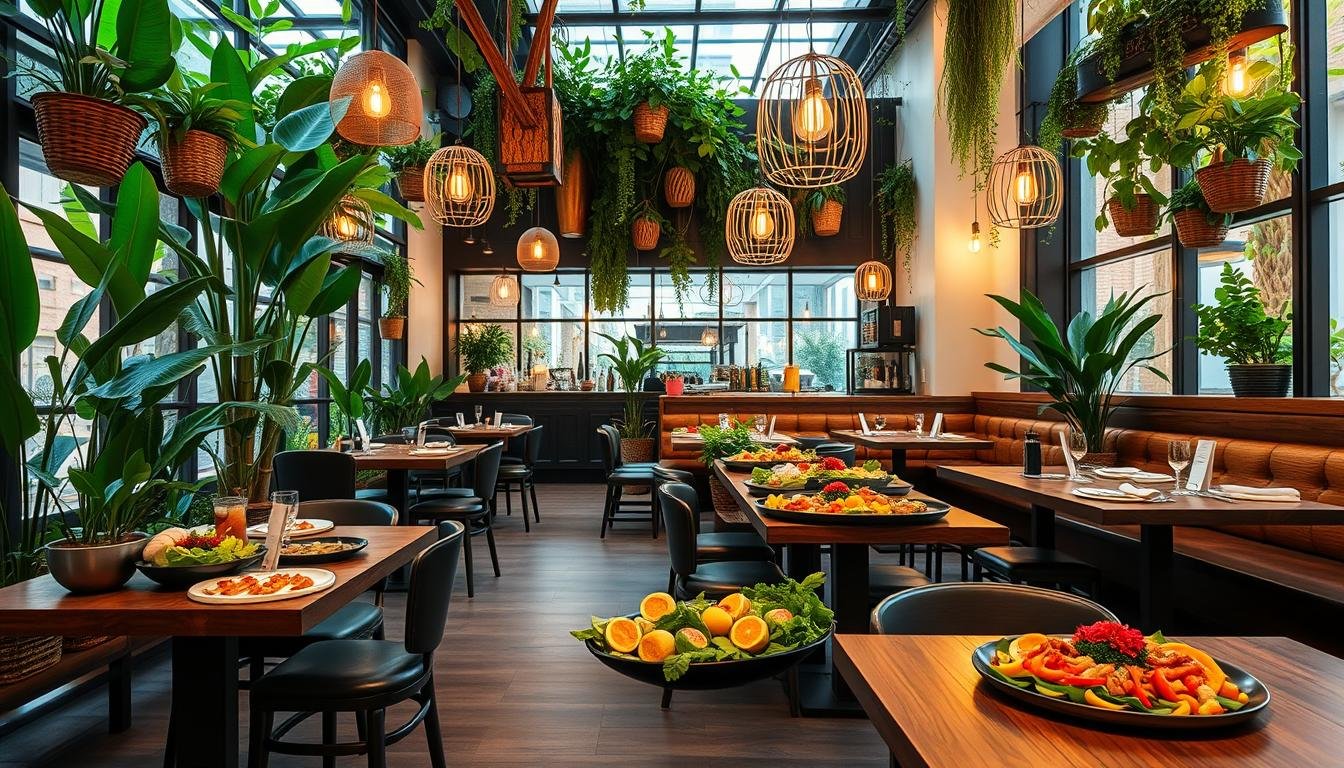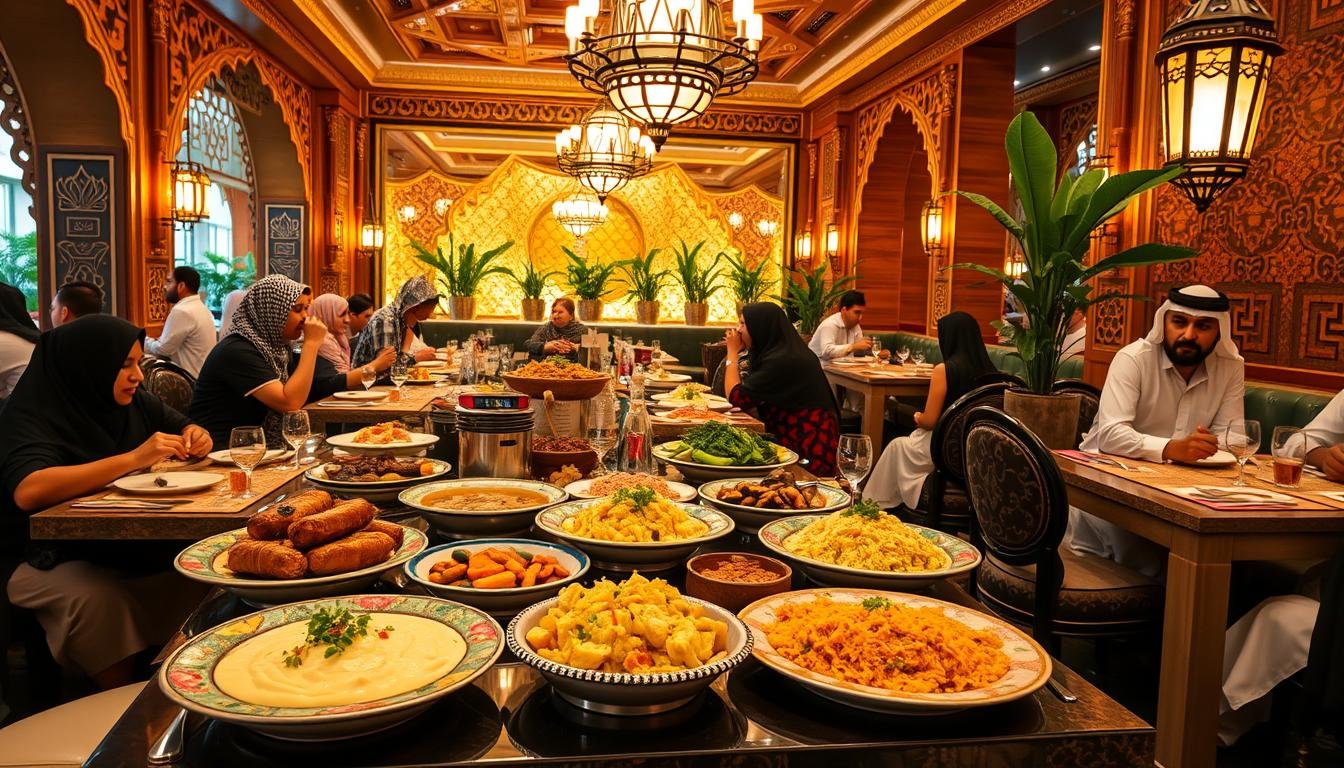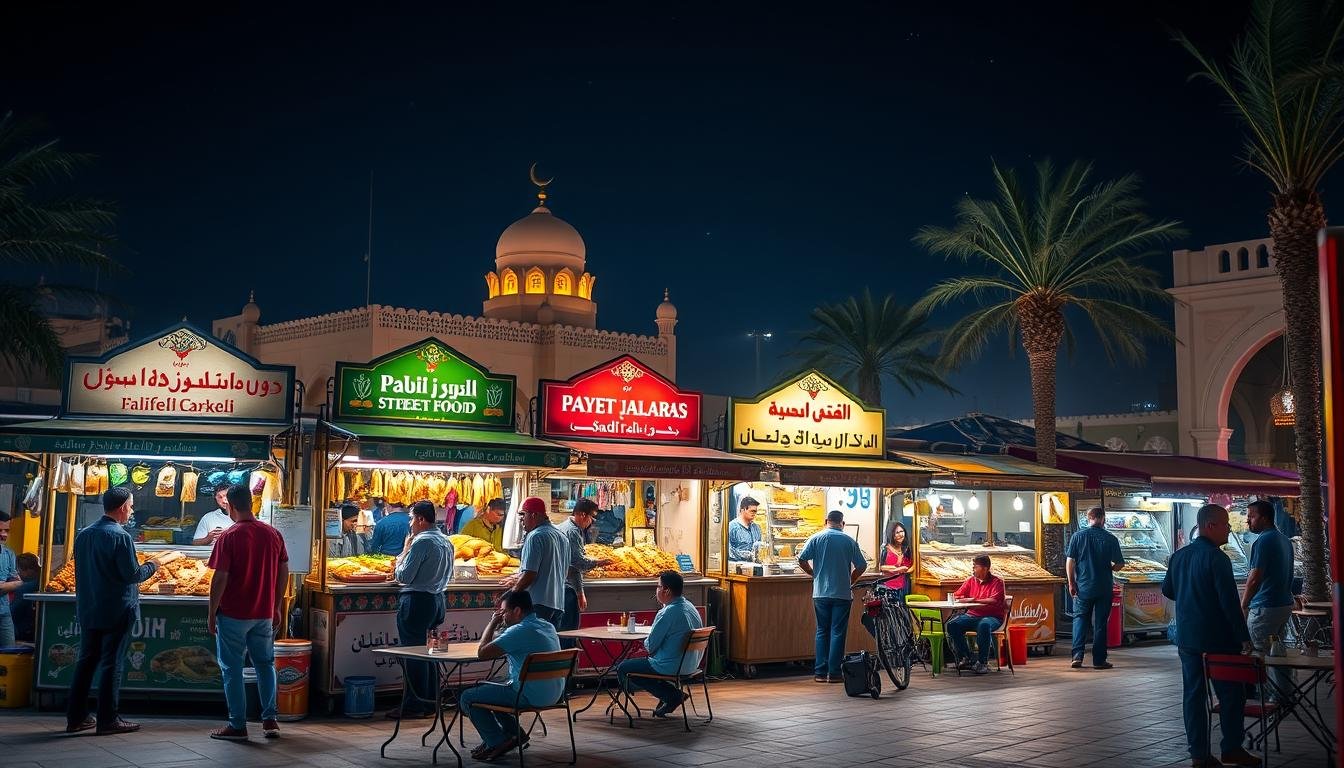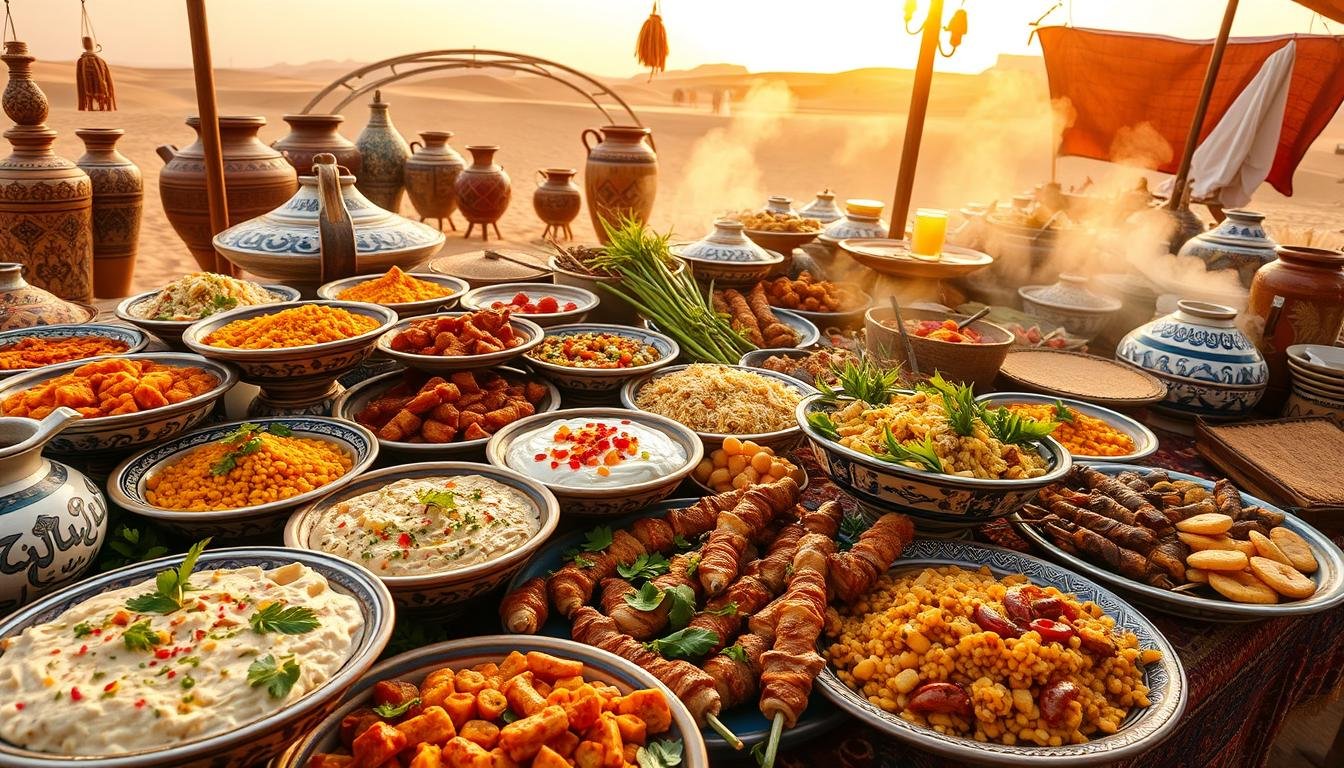I’m from Saudi Arabia and I’m excited to share with you our traditional breakfast dishes. These meals are hearty, comforting, and full of flavor. They show the rich culinary heritage and cultural traditions of my homeland.
In this guide, I’ll show you the secrets behind our breakfast dishes. You’ll learn about the flavors, how they’re made, and their cultural importance. Whether you love Saudi food or just want to try something new, this article will interest you. Let’s explore the true essence of traditional Saudi Arabian breakfast traditions together.
Your Guide to Traditional Saudi Arabian Breakfast Dishes
Exploring Saudi Arabia’s rich food culture, we find amazing breakfast dishes loved by locals. These include middle eastern dishes and emirati breakfast favorites, all part of saudi cuisine. They make for a delicious start to your day.
Traditional Saudi breakfasts mix savory and sweet flavors beautifully. Foul medames, a fava bean stew, is a favorite, served with herbs, eggs, and flatbread. Shakshuka, with its spicy tomato base and poached eggs, also stands out, showing the area’s Mediterranean touch.
On a Saudi breakfast table, you’ll see many fresh breads. There are mutabbaq pastries and khubz, a flatbread for toppings and dips. And don’t miss the qahwa, a coffee with cardamom, served in fancy cups.
Looking for a filling breakfast or something sweet? The traditional saudi arabian breakfast dishes take you on a tasty journey. They celebrate the Kingdom’s rich culture.
The Cultural Significance of Saudi Breakfast Traditions
Saudi Arabian breakfast is more than a meal. It shows the country’s rich culture. From morning rituals to family gatherings, breakfast is very special.
Morning Rituals in Saudi Households
Many Saudi homes start the day with coffee and foul medames. Families gather, talk, and enjoy these dishes together. It’s a time for sharing and connection.
Family Gatherings and Breakfast Customs.
Breakfast in Saudi Arabia is a family affair. Grandparents, parents, and kids share meals. They pass down recipes and stories, strengthening family bonds.
Regional Variations Across the Kingdom
While some dishes are common, Saudi breakfasts vary by region. Northern breads and southern spices highlight the kingdom’s diversity. Each area has its own breakfast traditions.
| Region | Breakfast Specialty | Key Ingredients |
|---|---|---|
| Northern Saudi Arabia | Mutabbaq | Flour, eggs, cheese, meat |
| Southern Saudi Arabia | Shakshouka | Tomatoes, peppers, eggs, spices |
| Central Saudi Arabia | Foul Medames | Fava beans, olive oil, garlic, lemon |
Saudi breakfast traditions are more than food. They show the country’s values, family ties, and diversity. These customs enrich arabic food culture, saudi cuisine, and middle eastern dishes for everyone.
Essential Ingredients in Saudi Arabian Breakfast
Saudi Arabia’s breakfast dishes are filled with essential ingredients. From fava beans to dates, these items are key to the flavors and culture of Saudi mornings.
The fava bean, or “ful medames,” is a mainstay. These beans are cooked with spices and herbs, making a hearty breakfast.
Eggs are also crucial, enjoyed in many ways. You’ll find scrambled, fried, and in shakshuka, a dish with spicy tomato sauce.
Dates are a favorite, known for their sweetness and health benefits. They’re enjoyed on their own or in dishes like mutabbaq, a flaky pastry.
Spices add depth to Saudi breakfasts. Cinnamon, cardamom, cumin, and coriander blend to create unique flavors.
Understanding these ingredients shows the value of Saudi Arabian breakfasts. It highlights the rich culture and culinary skill behind this cuisine.
| Ingredient | Significance in Saudi Breakfast | Dishes Featuring the Ingredient |
|---|---|---|
| Fava Beans | Protein-rich legume, staple of many traditional breakfast dishes | Ful medames, a classic Saudi breakfast staple |
| Eggs | Versatile ingredient used in a variety of preparation methods | Scrambled eggs, fried eggs, shakshuka |
| Dates | Beloved fruit with cultural and nutritional significance, often served as a standalone snack or incorporated into dishes | Mutabbaq, a flaky pastry filled with a date-based spread |
| Spices | Aromatic seasonings that lend depth and complexity to the flavors of Saudi breakfast fare | Cinnamon, cardamom, cumin, coriander, and more |
Foul Medames: The Hearty Morning Staple
In Saudi Arabia, foul medames is a favorite breakfast dish. It’s a savory fava bean stew with deep roots in Middle Eastern culture. It’s a big part of the local food and traditions.
Traditional Preparation Methods
Making foul medames is a tradition that’s been passed down for ages. First, fava beans are soaked and simmered until they’re soft and creamy. Then, garlic, cumin, and spices are added, giving the stew its unique taste.
Regional Variations and Toppings
- In Saudi Arabia, foul medames can taste and look a bit different in each region. Some add diced tomatoes, lemon juice, or chili powder for extra flavor.
- People often top it with hard-boiled eggs, pickled veggies, and olive oil. These add to the dish’s flavor and texture.
Health Benefits and Nutritional Value
Foul medames is not just tasty; it’s also very nutritious. It’s full of protein, fiber, and carbs, making it a great breakfast. It also has antioxidants from herbs and veggies, boosting its health benefits.
| Nutrient | Amount per Serving |
|---|---|
| Calories | 250 kcal |
| Protein | 15 g |
| Fiber | 10 g |
| Vitamin C | 20% RDI |
| Iron | 25% RDI |
Foul medames is loved for breakfast or family meals. It’s a nutritious favorite in Saudi cuisine and Middle Eastern dishes.
Shakshuka: A Middle Eastern Breakfast Favorite
Shakshuka is a beloved breakfast dish in the Middle East, especially in Saudi Arabia. It’s a meal of eggs poached in a savory tomato sauce. This dish is deeply rooted in arabic food culture and the region’s rich culinary heritage.
The core of shakshouka (eggs in tomato sauce) is simple yet satisfying. It starts with a sauce of ripe tomatoes, onions, and spices like cumin, paprika, and chili peppers. Eggs are then cracked and cooked until the whites are set and the yolks are runny. This creates a perfect blend of flavors and textures.
While the basic recipe is known across the middle eastern dishes, each region in Saudi Arabia has its own twist. Some add bell peppers, eggplant, or merguez sausage. Others use local herbs and spices to give it a unique flavor.
| Ingredient | Quantity |
|---|---|
| Tomatoes, diced | 1 (14oz) can |
| Onion, diced | 1 medium |
| Garlic, minced | 3 cloves |
| Cumin | 1 tsp |
| Paprika | 1 tsp |
| Chili powder | 1/2 tsp |
| Eggs | 4-6 |
| Salt and pepper | To taste |
Shakshouka is loved for breakfast, brunch, or any time. It’s a cherished part of arabic food culture in Saudi Arabia. Its vibrant colors, savory aroma, and comforting flavors celebrate the region’s culinary traditions.
The Art of Making Perfect Mutabbaq
Explore the world of mutabbaq, a favorite Saudi breakfast dish. It’s loved by locals and visitors. This traditional pancake is a mix of old techniques and tasty flavors.
Step-by-Step Preparation Guide
Making perfect mutabbaq needs attention to detail and cooking skill. Start by mixing flour, eggs, milk, and a bit of salt. This makes a batter that’s smooth and easy to pour.
Heat a skillet or griddle over medium heat. Pour the batter into it, swirling it to cover the surface evenly. As it cooks, watch it carefully. Flip it gently to cook both sides well.
The secret to flaky mutabbaq is in the heat and timing. This skill has been passed down through generations of Saudi cooks.
Popular Fillings and Variations
Mutabbaq can be filled with many tasty ingredients. You can use spiced ground meat, cheese, or veggies for savory options. Or try sweet fillings like dates, honey, or chocolate.
Try mutabbaq plain, filled, or with Saudi cuisine on the side. It’s a must-try for those wanting to explore traditional Saudi Arabian breakfast dishes. Discover the joy of mutabbaq (pancakes).
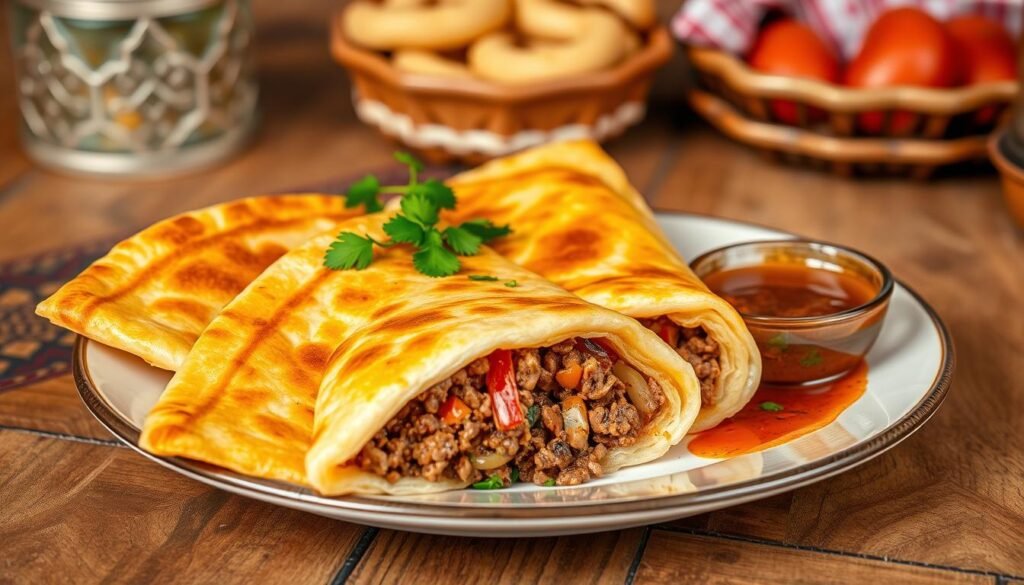
Traditional Saudi Breakfast Breads
Saudi Arabian cuisine is known for its rich breakfast offerings. Traditional breads like tamees and murtabak are key parts of this. They are not just food but also a big part of the arabic food culture and middle eastern dishes in Saudi.
Tamees: The Quintessential Flatbread
Tamees is a must-have breakfast bread in Saudi Arabia. It’s fluffy and leavened, baked in a clay oven called a taboon. This gives it a smoky flavor. You can eat it alone, with sauces, or use it to scoop up dishes like foul medames.
Khubz: The Versatile Staple
Khubz is a common Arabic flatbread in Saudi breakfasts. It’s round and puffed up. You can eat it plain, with cheese, or as a sandwich with eggs, labneh, or za’atar. Making khubz requires the right ingredients and baking techniques, which vary by region.
Murtabak: The Savory Stuffed Delight
Murtabak is a favorite in Saudi breakfasts. It’s a savory stuffed pancake with minced meat, onions, and spices. After being folded and fried, it’s crispy and delicious. You can enjoy it alone or with sauces, making it a tasty start to the day.
| Bread Type | Description | Preparation Method | Regional Variations |
|---|---|---|---|
| Tamees | Fluffy, leavened flatbread | Baked in a traditional clay oven (taboon) | Variations in shape, size, and degree of char |
| Khubz | Round, puffed-up Arabic flatbread | Baked using a balance of ingredients and techniques | Toppings and fillings may vary across regions |
| Murtabak | Savory stuffed pancake | Dough stretched thin, filled, and fried | Fillings may include minced meat, onions, and spices |
These traditional Saudi breads nourish the body and connect generations. They are a cultural touchstone, enjoyed on their own or with other dishes. These breads show the rich culinary heritage of Saudi Arabia.
Qahwa: The Essential Saudi Coffee Experience
In Saudi Arabian cuisine and culture, qahwa is a key part. It’s not just a morning coffee, but a special tradition. It shows the heart of Saudi hospitality and how people connect.
Brewing Techniques and Etiquette
Making the perfect qahwa is an art in Saudi Arabia. The beans are roasted and ground, then simmered in a dallah pot. The coffee is poured into finjan cups with a special technique.
Drinking qahwa is more than just tasting it. It’s a sensory experience filled with tradition. Serving qahwa shows respect and care for guests. Every detail, from the coffee’s temperature to the pouring rhythm, is important.
Traditional Serving Customs
- Qahwa is served in small, handleless cups to enjoy the aroma.
- The host might add cardamom or saffron for extra flavor.
- Guests should sip slowly, enjoying the coffee and conversation.
- Getting refills is a sign of the host’s kindness and attention.
The qahwa ritual celebrates Saudi Arabian culture. It connects people across generations. It’s a tradition that remains dear to the Saudi people.

Sweet Breakfast Options in Saudi Cuisine
Saudi Arabian breakfasts are as sweet as they are savory. Dates and honey-drizzled pastries add a delightful touch. These dishes celebrate the country’s rich culinary heritage.
Dates are a big deal in Saudi Arabia. They’re sweet and carry deep cultural meaning. Guests are welcomed with dates and qahwa, or traditional coffee.
Saudi breakfasts also feature flaky pastries. Mutabbaq and baklava are favorites. They’re enjoyed with savory dishes for a perfect balance.
| Sweet Breakfast Dish | Description | Regional Variations |
|---|---|---|
| Dates | Plump, naturally sweet fruits that are a cultural icon in Saudi Arabia | Dates can be served plain, stuffed with nuts, or drizzled with honey |
| Mutabbaq | A flaky, crescent-shaped pastry that can be filled with sweet or savory ingredients | Different regions may have their own signature fillings, such as cheese or spiced ground meat |
| Baklava | A rich, flaky pastry made with layers of phyllo dough and filled with nuts and syrup | The type of nuts used and the intensity of the syrup can vary by region |
These sweet dishes are more than just tasty. They give energy for the day. They’re a key part of the traditional Saudi breakfast.
Modern Influences on Traditional Saudi Breakfast
The saudi cuisine has changed a lot, showing the impact of cultural exchange and global trends. In the Kingdom of Saudi Arabia, a new wave of chefs and home cooks are mixing old and new. They create exciting new tastes that everyone loves.
Contemporary Adaptations
Classic Saudi breakfast items like foul medames and shakshuka have been updated. Chefs are trying new ingredients, presentation styles, and cooking ways. This makes old favorites exciting again, pleasing both those who love tradition and those who like new things.
Fusion Breakfast Dishes
- New recipes that mix international tastes with saudi cuisine are becoming hits. Imagine Saudi-style mutabbaq with a Mexican twist or qahwa (Saudi coffee) with Latin American spices. These dishes show how creative Saudi cooking can be.
- At fancy hotels and resorts in Saudi Arabia, breakfast buffets offer a mix of old and new. They blend traditional Saudi dishes with dishes from around the world. This mix not only tastes great but also shows Saudi Arabia’s openness to the world while keeping its traditional saudi arabian breakfast dishes alive.
The saudi cuisine keeps growing, and the traditional saudi arabian breakfast dishes keep winning hearts. They show off Saudi Arabia’s rich culture and its bold spirit in the kitchen.
Healthy and Nutritious Saudi Breakfast Choices
I’m excited to share some healthy breakfast options from Saudi culinary traditions. Hummus with pita is a favorite, made from chickpeas, tahini, and spices. It’s not just tasty but also full of vitamins, minerals, and healthy fats.
Foul medames (fava bean stew) is another great choice. It’s a staple in Saudi homes, full of fiber, protein, and nutrients. You can top it with different ingredients to make it your own.
Saudi cuisine also offers many vegetable-based breakfasts for those who prefer plants. You can enjoy vegetable stews or fresh salads. These dishes are both nutritious and delicious, celebrating Saudi’s rich food traditions.
FAQ
What are the most popular traditional Saudi Arabian breakfast dishes?
Traditional Saudi Arabian breakfasts often include foul medames, a fava bean stew. Shakshouka, with eggs in tomato sauce, is also popular. Mutabbaq, savory pancakes, and breads like tamees and khubz are favorites too.
What is the cultural significance of Saudi breakfast traditions?
Breakfast in Saudi Arabia is deeply rooted in culture. It involves morning rituals and family gatherings. These traditions are key to daily life and social bonds.
What are the key ingredients used in traditional Saudi Arabian breakfast dishes?
Saudi breakfasts often feature fava beans, eggs, and dates. Spices and staple breads are also common. These ingredients add unique flavors and hold cultural and nutritional value.
How is foul medames, a popular Saudi breakfast dish, prepared and enjoyed?
Foul medames is a fava bean stew loved for breakfast. It’s simmered with spices and topped with eggs, tomatoes, and olive oil. It’s known for its hearty and flavorful taste.
What is the significance of qahwa, the traditional Saudi coffee, in breakfast culture?
Qahwa is a key part of Saudi breakfasts. The ritual of brewing and serving it is deeply ingrained in hospitality. It’s a symbol of cultural significance and etiquette.
What are some of the sweet breakfast options found in Saudi cuisine?
Saudi breakfasts also include sweet options. Dates, honey, and pastries offer a balance of flavors and energy for the day.
How have modern influences impacted traditional Saudi breakfast dishes?
Modern twists have influenced traditional Saudi breakfasts. While staying true to heritage, new flavors and international inspirations have introduced innovative options.
What are some of the healthier and more nutritious breakfast choices in Saudi cuisine?
Options like foul medames, hummus, and vegetable dishes are nutritious. They’re not only tasty but also provide essential nutrients, making them a healthy start to the day.
Don’t forget to share your experience in the comments and follow us on social media at the bottom of the site.
